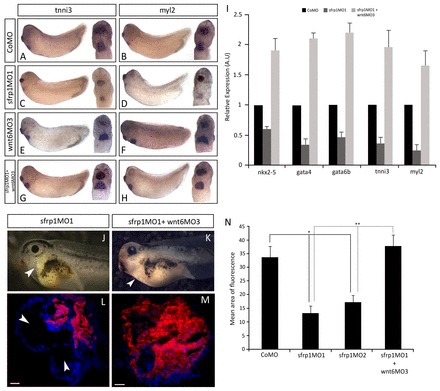Fig. 7.

sfrp1 promotes heart development by restraining wnt6-mediated repression. (A-H) WISH analysis on stage 32 embryos highlighting the gene expression pattern of structural myocardial differentiation markers. Embryos injected with CoMO showed normal expression (A,B), whereas embryos injected with sfrp1MO1 showed reduced myocardial gene expression (C,D). Co-injection of wnt6MO3 and sfrp1MO1 caused an enlarged area of myocardial marker gene expression (G,H) reminiscent of the phenotype caused by injection of wnt6MO3 alone [E,F; compare with figure 2 in Lavery et al. (Lavery et al., 2008b)]. (I) qRT-PCR analysis at stage 32 of MO-injected embryos shows decreased gene expression of both cardiogenic transcription factors and myocardial differentiation markers in sfrp1MO1-injected embryos and an increase in both when sfrp1MO1 was co-injected with wnt6MO3, relative to the normal expression in CoMO-injected embryos. (J,K) Phenotype of sfrp1MO1-injected embryo and for embryo co-injected with sfrp1MO1 and wnt6MO3 at stage 41. Note the change in heart size (arrowheads). (L,M) Differentiation of the heart was analysed at stage 41 by cTnT immunofluorescence (red) with DAPI counterstaining (blue). sfrp1MO1 injection causes reduced cTnT expression (L), but embryos co-injected with sfrp1MO1 and wnt6MO3 show enlarged cTnT expression indicating an increase in the amount of differentiated myocardial tissue [M; compare with figure 2 in Lavery et al. (Lavery et al., 2008b)]. Arrowheads indicate loss of myocardial tissue (J,L) and increase in heart size (K). (N) Quantification showing a significant increase in the amount of myocardial tissue as represented by cTnT expression in co-injected embryos compared with embryos injected with sfrp1MO1 alone, which exhibited a significant loss of myocardial tissue relative to CoMO. n=4, **P<0.01 and *P<0.05. Data are mean ± s.e.m. Scale bars: 200 μm in L,M.
